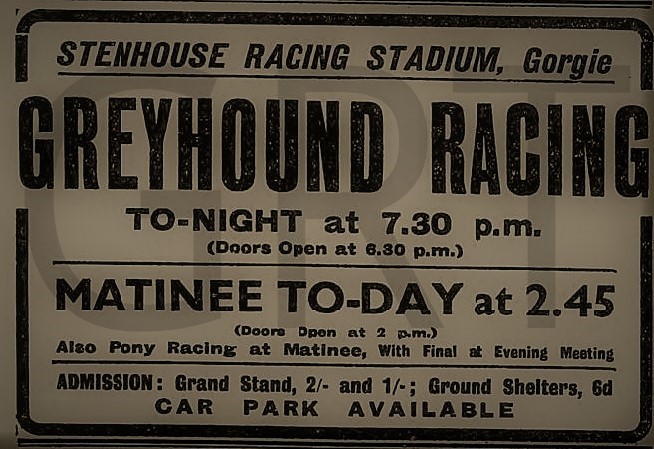Stenhouse Stadium, Gorgie, Edinburgh.
POSTCODE———————————-EH11 3XX
LOCATED————————————Just over two miles south west of Edinburgh City Centre, on the banks of the Water of Leith and one mile south west of Murrayfield Rugby Stadium.
ORIGINAL SITE—————————–Unoccupied land owned by Saughton Mills.
DATE CONSTRUCTED——————–Early 1900’s as a football ground.
DATE VENUE OPENED——————-Early 1900’s for football.
Meaning other sports may have taken place prior to the arrival of Greyhound Racing.
FIRST MEETING—————————–June 25th 1932.
Greyhound Racing only.
LICENSED OR INDEPENDENT———-Early independent then switrhched to NGRC in 1935.
All venues covered would have to be licensed with the government, licensed suggested in this section would refer to tracks operating under NGRC Rules.
INSIDE OR OUTSIDE HARE TYPE——Not known.
Please note that the Electric Hare suggested is only a guidance and would have been in operation for a certain amount of time at this venue. Although it is not necessarily guaranteed that it was operational all the time, as other types of lure may have been used and updated as time progressed.
DISTANCES———————————–500 and 525 yards.
Please note that most racing venues distances had become varied throughout the years, the ones given above were at once point set and offers only a guidance to the track size.
CIRCUMFERENCE—————————Don’t know.
Please note that alterations at most racing venues throughout its existence would see that the circumference of the track would vary, the one shown above offers only a guidance to the track size.
BIG RACE NAMES—————————Nothing known of.
STADIUM SHARED WITH——————Pony Racing, Amateur football, Harness Racing and Stock Car Racing.
LAST MEETING——————————-Possibly July 1949.
Greyhound Racing only.
STADIUM CLOSURE DATE—————-Early 1970’s.
Meaning other sports may have taken place after Greyhound Racing had ceased.
STADIUM DEMOLITION——————-1970’s
BUILT ON SITE——————————-Stenhouse Mill Wynd Industrial Estate on Stenhouse Mill Lane.
In some cases, structure’s that originally covered the venue after the stadium had been demolished, may have been themselves demolished too, so the one described is more likely to be the one which now presently covers the site.
EVIDENCE LEFT TODAY——————-The old results tower remained derelict for almost half a century later, yet it is only in the last decade or so that it was demolished.
FURTHER COMMENTS——————–None











Stenhouse Greyhound Stadium was located roughly two miles south west of Edinburgh’s city centre, and became one of four greyhound tracks that would operate within the cities boundaries. The original site had been a section of land owned by the Saughton Saw Mills, which had took its shape due to the curvature of the Water Of Leith. The venue lay close to Gorgie Road, a busy link that ran public transport directly to the city centre, which possibly may have played its part in the development as a football ground during its early days of the 1900’s.
The venue also became the home to Scottish Junior football club, Civil Service Strollers, who by 1930, had moved on to other pastures, leaving Stenhouse to stage regular Pony and Harness Racing. Yet it was during the early months of 1932 that a group of Greyhound Racing enthusiasts signed a lease with the council to allow them to lay a track inside the Trotting Circuit. Construction of a new grandstand also took place, with the Stenhouse track beginning life as a flapping track.
Advertisements were placed in the local press, inviting local owners and trainers to bring their greyhounds and grade them, ready for its opening meeting. Stenhouse’s first meeting came on the afternoon of the 25th of June 1932, with a staggering 10,000 racegoers in attendance, who happened to witness a greyhound called Rebuke win the first of a seven race card. The meeting also hosted pony racing which added extra interest to the event. Another evening meeting followed that same day, with another 10,000 watching a seven race card. Distances were run over 500 and 525 yards with six greyhounds chasing a described electrical mechanical hare. In December 1933, the track’s name appeared once again in the local press, but this time having been summonsed by the government, due to the illegal use of a totalisator system at the track.
More publicity during December 1935 had revealed that the GRA had fought off competition from other syndicates to purchase the Stenhouse Stadium. Stenhouse had become the third Edinburgh Greyhound Racing venue to be controlled under the guidance of the GRA, after they had existing interests in the already established Powderhall Stadium and the Marine Gardens track, incidentally both located on the opposite side of the city. But the purchase of Stenhouse had triggered the relaxation of the GRA’s interest in the Marine Gardens venue, which contributed the closure of Greyhound Racing at the Gardens in 1936.
The years following the Second World War witnessed a lack of interest from the public at meetings at Stenhouse, with proof of evidence in the totalisator figures, showing that Stenhouse was turning over only a tenth of what Powderhall was taking at the time. The uncertain future of Stenhouse now lay in the hands of the GRA, who realised that the city’s interest in Greyhound Racing lay at Powderhall, a decision had to be made which would signify the end of Greyhound Racing at Stenhouse by the Summer of 1949.
Once the greyhounds had gone, Stenhouse continued hosting other sporting activities, such as Harness Racing, Show Jumping, Football and later Stock Car Racing. By the early 1970’s, the stadium lay in poor run down condition, with little use of the grounds, which would eventually lead up to the stadiums demolition.
The site was later covered by Stenhouse Mill Wynd Industrial Estate on Stenhouse Mill Lane, but amazingly enough the old results tower remained in its position although derelict, for another forty years before that too was eventually demolished.
A programme, photograph or even memorabilia for this track is required for this page, if you can help please contact me.

Recent Comments